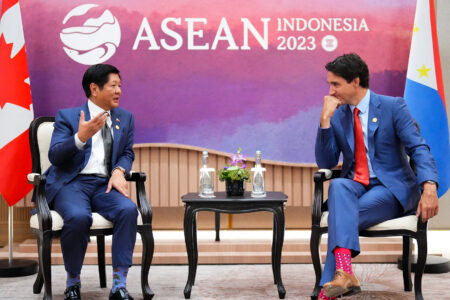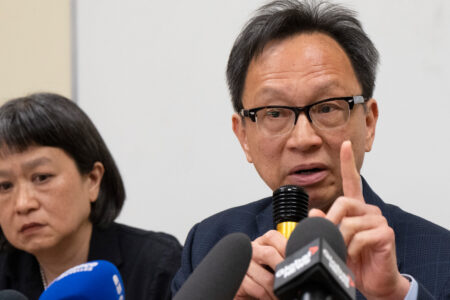
Over the past two decades, China’s rise in power and influence has reshaped global economics and politics. There are now, as Paul Evans of the University of British Columbia puts it, two suns in the sky, China and the United States. China is an unavoidable and necessary player on matters ranging from global financial markets to international security and the environment. China has become our second most important trading partner, and the most significant challenge to our ability to adapt to a changing world.
In Canada, attention has focused on Chinese investments in natural resources, notably in the oil and gas sector in Western Canada. It is important to note, however, that China’s emergence will have profound and wide-ranging implications for all regions of the country. This article will explore the economic implications for Quebec in particular, and offer recommendations aimed at optimizing Quebec’s advantages and opportunities in the Chinese marketplace.
At a national level, Prime Minister Stephen Harper’s government has progressively shifted its position on China from dramatically highlighting the differences in governance and values of our two countries, to a broader assessment of Canada’s interests and the need to engage this second sun. Last year’s appointment of John Baird, who is close to Harper, as Minister of Foreign Affairs, signalled as strongly as possible the change in approach. During a visit to China in July 2011, Baird declared the start of a “new era” in relations with China, “a country that is both a clear priority for our government and important to our economy.” The Prime Minister’s subsequent visit to China in February 2012 with some 40 Canadian private sector executives in tow produced commercial deals with a potential value of more than $3 billion, as well as series of bilateral agreements in sectors ranging from energy to education.
From a commercial standpoint, arguably the most significant result of Harper’s visit was the conclusion — after 18 years of on-and-off negotiations — of the landmark Foreign Investment Promotion and Protection Agreement (FIPA) with China. Although the agreement still needs to be reviewed and ratified by both parties, the clear intent is to encourage greater investment flows between by establishing minimum standards of treatment and rules governing transparency, expropriation protection and dispute settlement. By shielding foreign investors from “discriminatory and arbitrary” practices, the agreement is expected to provide a further boost to bilateral trade, which has tripled in a decade to nearly $58 billion in 2010.
Naturally, China is immune to neither global economic trends nor the cyclical downturns common to market economies. Its GDP growth of 8 percent in 2012 represents a significant decline from almost 12 percent two years ago. The pace of growth in energy demand is also slowing. Still, China has become Canada’s third-largest export market and our second most important source of imported goods. What happens there increasingly matters here.
Companies in Quebec and elsewhere that hope to take advantage of China’s growth would be well advised to pay attention to its 12th Five-Year Plan, which covers the period from 2011 to the 2015. Every five years since the early 1950s, the central government has published a detailed outline of the country’s economic and social goals for the next half-decade. Broadly speaking, the most recent plan (now officially termed a “guideline”) seeks to establish China as a producer of high-value manufactured goods rather than of low-cost products, encourage domestic consumption, and reduce income disparities. In the words of Premier Wen Jiabao, the objective of economic expansion is “not only to make the cake of social wealth as big as possible, but also distribute the cake in a fair way and let everyone enjoy the fruits of reform.”
The current Five-Year Plan sets out a 7 percent annual GDP growth target, but also acknowledges the less desirable consequences of rapid economic expansion, including pollution, intensive energy use and resource depletion. Hence, among the key initiatives of the current plan are commitments to improve the lives of Chinese citizens and make a shift toward a more sustainable path to growth.
In pursuit of these goals, the Five-Year Plan establishes the following seven “strategic emerging industries”: new energy, energy conservation and environmental protection, biotechnology, new materials, new information technologies, high-end equipment manufacturing and clean-energy vehicles.
With regard to new energy and environmental protection, the Five-Year Plan encourages foreign businesses to establish green-energy R&D facilities and to apply for government-funded R&D projects in partnership with Chinese firms. As well, the plan establishes the goal of making China the world’s largest maker of electric vehicles, with an interim production goal of 1 million electric vehicles annually by 2015.
Last year’s appointment of John Baird, who is close to Harper, as Minister of Foreign Affairs, signalled as strongly as possible the change in approach. During a visit to China in July 2011, Baird declared the start of a “new era” in relations with China, “a country that is both a clear priority for our government and important to our economy.”
In the same spirit, China no longer wishes to be known mainly as a centre of low-value manufacturing and final assembly; the goal is to make the transition from “made in China” to “designed in China.” In the priority areas of biotechnology, new materials, new information technologies and highend equipment manufacturing, China needs to build research and development (R&D) capacity. As the Five-Year Plan acknowledges, this will necessitate a stronger intellectual property protection and management framework.
All of this creates a wide range of opportunities for foreign manufacturers, service providers and investors. In many respects, Quebec’s key industries — aerospace, ground transportation equipment, life sciences, agri-food, light metals, information technology and microelectronics — are particularly well positioned to take advantage of the reorientation of China’s priorities.
A handful of Quebec firms have already successfully penetrated the massive Chinese market. Montreal-based Power Corporation of Canada (PCC), for one, has been active in China since 1978 and has invested in many different sectors of the Chinese economy, including real estate, transportation, communications and power generation. It was the first Canadian enterprise to win the coveted status of “qualified foreign institutional investor,” which allows it to buy and sell yuan-denominated shares on Chinese stock exchanges.
Bombardier has had links with China since 1954, and has a history of three joint ventures and seven wholly foreign-owned enterprises there. For its part, CAE has been involved in a joint venture with China Southern Airlines since 2002. Based in Guangdong province, the Zhuhai Flight Training Centre, of which CAE owns 49 percent, provides aviation training services for more than 12,000 pilots annually, representing a variety of commercial aircraft carriers, including Air China and China Eastern Airlines.
A more recent arrival in the Chinese market is Quebec City-based EXFO, a provider of test and service assurance solutions for wireless and wireline network operators and equipment manufacturers in the global telecommunications industry. In 2008 EXFO built a manufacturing facility in Shenzhen, its first production base outside Canada.
The experiences of PCC, Bombardier, CAE and EXFO underscore the extent to which China’s growth has created openings for Quebec-based enterprises. But those are only a few among many opportunities, most of which remain untapped.
As the Chinese middle-class expands, traditional consumption patterns are evolving. China will become the world’s leading importer of food and agricultural products within the next two decades. In 2010, the most recent year for which figures are available, only 2 percent of Quebec agrifood exports went to China. There is no reason why this number cannot grow considerably in the years ahead.
Also growing is the demand for goods and services related to child-raising, education and children’s entertainment. Montreal-based MEGA Brands, one of the world’s top 10 toy companies, began producing toys in China for export to other international markets, and since 2010 it has been selling an increasing number of made-in-Quebec toys to Chinese consumers.
TM4 Electro dynamic Systems, a subsidiary of Hydro-Québec, has developed opportunities in new energy technologies. It has done pioneering work in the field of electric propulsion systems, and it recently announced it had formed a partnership with Prestolite Electric Beijing Ltd. to develop and build electric-drive trains for buses and trucks, as well as commercial, off-road and marine vehicles. The new joint venture will target customers in China and throughout Southeast Asia.
These kinds of partnerships build on a long history of scientific research co-operation between Quebec and China, spanning biotechnology, genomics, proteomics (the study of proteins), the environment and sustainable development, health, information technology, marine sciences, new materials, and renewable energy.
China’s first high-level mission to Quebec took place in 1978. Since then, the two governments have signed a number of agreements to work together in the areas of education and training, health research, and science and technology. For example, the 2006 agreement between Quebec’s Minister of International Relations and China’s Ministry of Science and Technology sponsors scientific and technological collaboration projects. Researchers at McGill University are currently collaborating with scientists at Sichuan University in Chengdu City on a project aimed at uncovering the genetic factors behind male infertility.
Quebec has a particularly strong relationship with Shandong, the second most populous province in China, with a GDP of $600 billion — twice that of Quebec. In 2009, the province entered a science and technology co-operation agreement with Shandong on marine sciences. The Institut des sciences de la mer (ISMER), part of the Université de Quebec à Rimouski together with the Université de Laval, are collaborating with marine science institutes at the Ocean University of China in Qingdao.
Montreal-based Power Corporation of Canada (PCC), for one, has been active in China since 1978 and has invested in many different sectors of the Chinese economy, including real estate, transportation, communications and power generation. It was the first Canadian enterprise to win the coveted status of “qualified foreign institutional investor,” which allows it to buy and sell yuan-denominated shares on Chinese stock exchanges.
Clearly, China’s current Five-Year Plan also complements the Quebec government’s Plan Nord, the $80-billion, 25-year development plan focused on sustainable mining, forestry and energy. Realizing the Plan Nord will require massive infusions of capital, from within Canada and abroad.
Well-capitalized Chinese state-owned and private enterprises are wasting no time as they search for dependable supplies of natural resources and partnerships. Last fall, one of China’s largest nickel producers, Jilin Jien Nickel Industry Co., confirmed that it will invest a total of $800 million to mine a nickel deposit near the Inuit community of Kangiqsujuaq on the northern tip of Quebec. Separately, Wuhan Iron and Steel Group Corporation recently signed a joint venture agreement with Toronto-based Adriana Resources Inc. to develop and operate an iron ore mining complex in Nunavik, Quebec. Scheduled to open in 2016, the $13-billion Lac Otelnuk project — potentially the largest mining project in Canadian history — is expected to produce 50 million tons of iron ore a year over a period of up to 100 years. The project includes a new 815-kilometre railway line and the expansion of the Sept-Îles port (at the mouth of the St. Lawrence River), to accommodate enormous Chinamax ships, which can carry up to 400,000 tonnes of cargo.
But the flow of capital and ideas is not all one-way. The modern Chinese economy has been built on FDI, with inward flows currently exceeding $120 billion per year. Quebec companies interested in pursuing Chinese investment opportunities should first consult the official Catalogue for Guiding Foreign Investment, which lists areas in which foreign investment is welcome, as well as those in which it is prohibited. New areas in which investment is encouraged include environmental technologies, new textiles, chemical or mechanical manufacturing technologies and products, collection and treatment of waste, electronic products or equipment, energy-saving and environmental protection industries, new-generation information technology, and biotechnology. Moreover, many service-related industries have been added to the encouraged list, including venture capital enterprises, intellectual property rights services and motor vehicle charging stations.
China, Canada and the world keep changing, and the policy environment must keep up with the times. There are a number of initiatives that could be undertaken by government to assist Canadian and Quebec businesses that wish to succeed in the Chinese marketplace. The following are some examples of such initiatives.
A Canada-China free trade accord: At the February 2012 signing of the declaration of intent to conclude a Canada-China agreement on foreign investment, Premier Wen Jiabao said that China is interested in “stepping up” discussions of the feasibility of a full bilateral free trade accord (FTA). Canada’s response was positive but muted. Some officials and trade policy experts have voiced skepticism, citing the significant gap in the two countries’ trade regimes and the daunting resource requirements for such an exercise.
The prevailing Canadian view seems to be that FTA negotiations are something for the long term. Certainly there are questions around timing and capacity and how much negotiating leverage Canada could muster. Not up for question, however, are the potential benefits of an FTA as a driver of bilateral trade and investment, one that would leverage comparative advantage in a way that would boost domestic production, economic growth, employment and innovation while reducing costs for consumers. Our view is that launching FTA negotiations would represent a bold and even transformational step for Quebec and the rest of Canada. The size and the importance of the Chinese economy, our own dependence on trade and investment, and also the many complementarities between our two economies are factors that argue for putting China at the top of Canada’s FTA list. As of 2012, Canada is no longer looking from the outside in with respect to the Trans-Pacific Partnership (TPP) negotiations. On June 19, 2012, at the G20 Summit in Los Cabos, Mexico, Prime Minister Harper announced that Canada would be joining ongoing TPP trade negotiations to become part of the 11-member partnership. Japan has expressed an interest in joining the talks but has not officially joined as of yet. They are currently in discussion. China has also not officially joined.
In any event, China is busy establishing its own network of FTAs, and Canada’s business community should be pushing to make sure that we take up the challenge. We do not want to fall to the bottom of China’s list. Negotiating an FTA with China would be a long and challenging process, but we can make friends and do business during the journey. As an ancient Chinese proverb states: “Be not afraid of growing slowly. Be afraid only of standing still.”
Foreign Investment Promotion and Protection Agreement: The recent conclusion of the Canada-China Foreign Investment Promotion and Protection Agreement (FIPA) was an important stepping stone toward a free trade deal and a significant tool in its own right. For Canadians investing in China, the FIPA can be considered as an insurance policy. The same holds true for Chinese investors into Canada. But the agreement must not be seen as an end in itself. The business community must work closely with government to ensure that the FIPA is implemented without delay, and that it is understood and promoted as a vehicle that encourages and protects investment in both directions. The signing of the FIPA should be the catalyst for the creation of a long-term, business-driven investment promotion strategy.
Mentorships: To assist Canadian entrepreneurs in penetrating the Chinese market, the Quebec and other provincial governments should establish a low-cost mentorship program, drawing on the substantial number of successful Chinese-Canadian entrepreneurs. The provincial government, in partnership with a suitable business group, could organize and monitor the program; annual evaluations would ensure that it is fine-tuned to the needs of the business community. The program would cover the expenses of mentors, while the Canadian embassy in Beijing and the consulates general would provide back-up support.
Investment promotion: To attract foreign direct investment, Quebec should organize a targeted five-year program to inform young Chinese business people of the investment climate and business potential in Quebec. The program should include detailed information on how to qualify as an immigrant to Quebec under the Provincial Nominee Program, and should inform interested entrepreneurs of specific business opportunities. At the same time, Quebec should launch a three-year investment promotion project aimed at Chinese multinational firms that have already invested elsewhere in Canada or the United States. The project would entail studying the business plans of specific Chinese companies and determining where Quebec can offer investment opportunities that are as great as, or greater than, those offered by other jurisdictions. The goal would be to develop “the case for Quebec,” individualized for each firm. A Quebec/ China investment promotion representative, reporting to the Quebec Premier, would then be tasked with selling the opportunity to the target company.
Universities: The Quebec government should review its immigration policies so as to facilitate the granting of a greater number of university student visas and draw more highly skilled immigrants from China. The Canadian Experience Class already allows temporary foreign workers and international students who have graduated from Canadian institutions to apply for permanent residence. The impact of this program on Quebec should be reviewed to determine if it can be enhanced to increase student flows.
It is relatively easy to assemble ideas for improving the Quebec/China business environment. It is another matter to agree on the best of these, and to assemble the political and financial capital to put them into effect. What is indisputable is that China’s significance will only increase, and not only in terms of economics. The good news is that there is room for everyone with vision and ambition.
Photo: Shutterstock by Darryl Brooks







